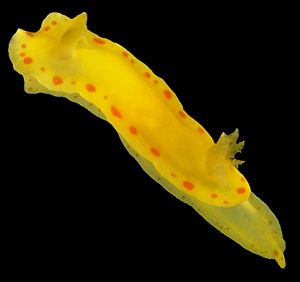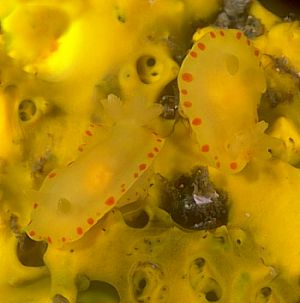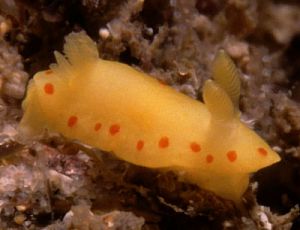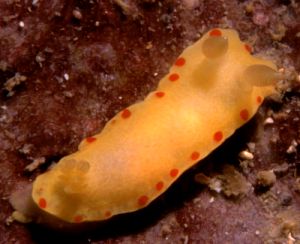

Noumea sulphurea
Rudman, 1986
Order: NUDIBRANCHIA
Suborder: DORIDINA
Superfamily: EUDORIDOIDEA
Family: Chromodorididae
DISTRIBUTION
Southern Australia (New South Wales to Western Australia)
PHOTO
UPPER: Shelly Beach, Manly, Sydney, New South Wales; 7 specimens (12, 15, 15, 16, 16, 17, 18 mm long alive), 6 m, 27 March 1984, AM C141473.
LOWER: Jibbon Head, Port Hacking, Sydney, New South Wales; 2 specimens (20, 22 mm long alive), 10 m, 5 April 1983, AM C138212. On food sponge Darwinella oxeata. Photos: Bill Rudman
RELATED TOPIC
There are some differences in colour between specimens from New South Wales and those from
southern Australia. See separate page for southern colour form. In New South Wales animals the whole of the body is a uniform bright yellow with regular orange spots around the mantle edge, sometimes touching the edge but usually just submarginal. There is also a submarginal row of orange spots around the foot, those along the side of the foot being smaller than the spots on the mantle, while those on the posterior visible part of the foot are of similar size to the mantle spots. In some smaller specimens microscopic white specks can be seen scattered over the mantle. The rhinophores and gills are translucent yellow and the rhinophore club is tipped with translucent white. The gills are simple and arranged in a circle around the anus. The mantle glands are single and ovate, arranged in a submarginal band around the mantle edge.
Noumea sulphurea has a wide distribution around southern Australia from New South Wales to Fremantle in Western Australia. Animals from Tasmania, Victoria and South Australia [see separare page] differ from those from Western Australian and New South Wales in having very noticeable white specks over the mantle and translucent, rather than opaque, orange spots.
In New South Wales and Tasmania this species is always found on yellow species of the sponge genus Darwinella identical in colour to the nudibranch. In Victoria, South Australia and Tasmania there is another species of Noumea, N. closei which is also found on the same, or very similar looking sponges. The only external difference between the two species of Noumea is that there are a few orange spots scattered over the central part of the dorsum as well as around the edge in N. closei. When preserved in formalin N. sulphurea loses its colour and becomes a pale translucent pinkish colour. Noumea closei on the other hand darkens to a deep reddish-brown almost black colour.
Reference:
• Rudman, W.B. (1986) The Chromodorididae (Opisthobranchia: Mollusca) of the Indo-West Pacific: Noumea flava colour group. Zoological Journal of the Linnean Society, 88: 377-404.
Rudman, W.B., 2001 (March 28) Noumea sulphurea Rudman, 1986. [In] Sea Slug Forum. Australian Museum, Sydney. Available from http://www.seaslugforum.net/find/noumsulp1
Related messages
Noumea sulphurea from New South Wales
March 31, 2001
From: Erik Schloegl


Dear Bill,
Here are two photos of a species which I tentatively identified as Noumea sulphurea from one of Neville Coleman's books. Though I'm surprised that it's not yet on the Forum, since he cites you as the person who described the species...
The upper photo was taken on 15 April, 1999 at Camp Cove, Sydney Harbour. The depth was 4m, the substrate rocky reef.
The second photo was taken on 18 March, 2000 at a dive site called "The Docks", inside Jervis Bay, New South Wales. The depth was 15m, the substrate rocky reef.
Best wishes,
Erik
Erik.Schlogl@uts.edu.au
Schloegl, E., 2001 (Mar 31) Noumea sulphurea from New South Wales. [Message in] Sea Slug Forum. Australian Museum, Sydney. Available from http://www.seaslugforum.net/find/4068Dear Erik,
Thanks for the photos of this old favourite. I am afraid it's not the only 'local' animal that should be on the Forum but isn't. Unfortunately there are only 24 hours in the day. I have been avoiding these yellow Noumea species as I knew they would take some time to add to the Forum. The southeastern Australian ones have interesting geographic colour variants, which I presume is probably a case of mimicry, and so I couldn't just add one, they all needed to go up at the same time.
In particular compare the Bass Strait colour form of Noumea sulphurea with Noumea crocea and the yellow colour form of Noumea haliclona. Both N. haliclona and N. sulphurea appear to have a colour form which matches that of Noumea closei in the one graphic area that the three species overlap. Perhaps a coincidence, but I tend to think it is at a 'coincidence' at least worth considering a little more fully.
I have also prepared a Noumea flava Colour Group Page to make it easier to compare these yellow chromdorids.
Best wishes,
Bill Rudman
